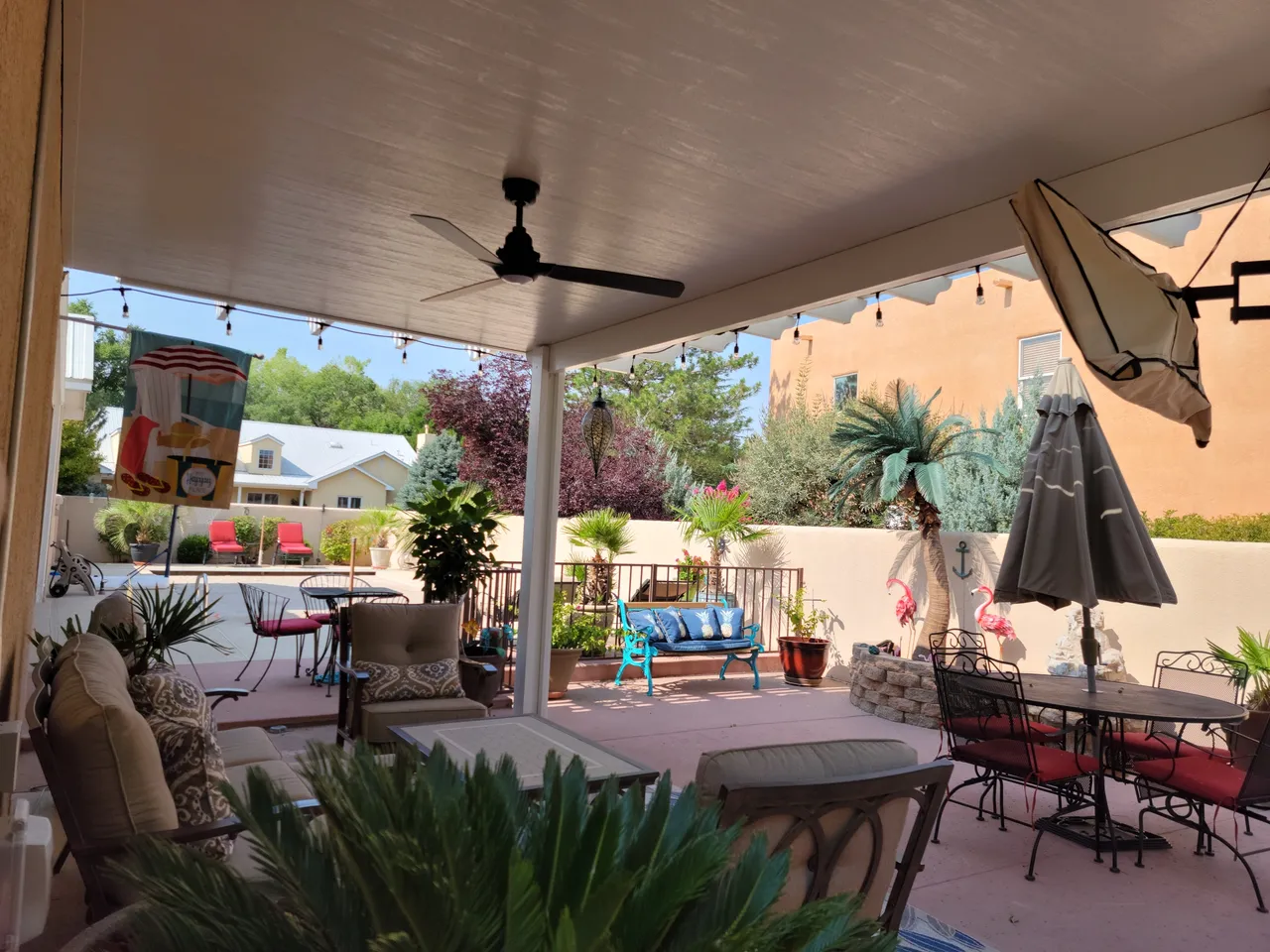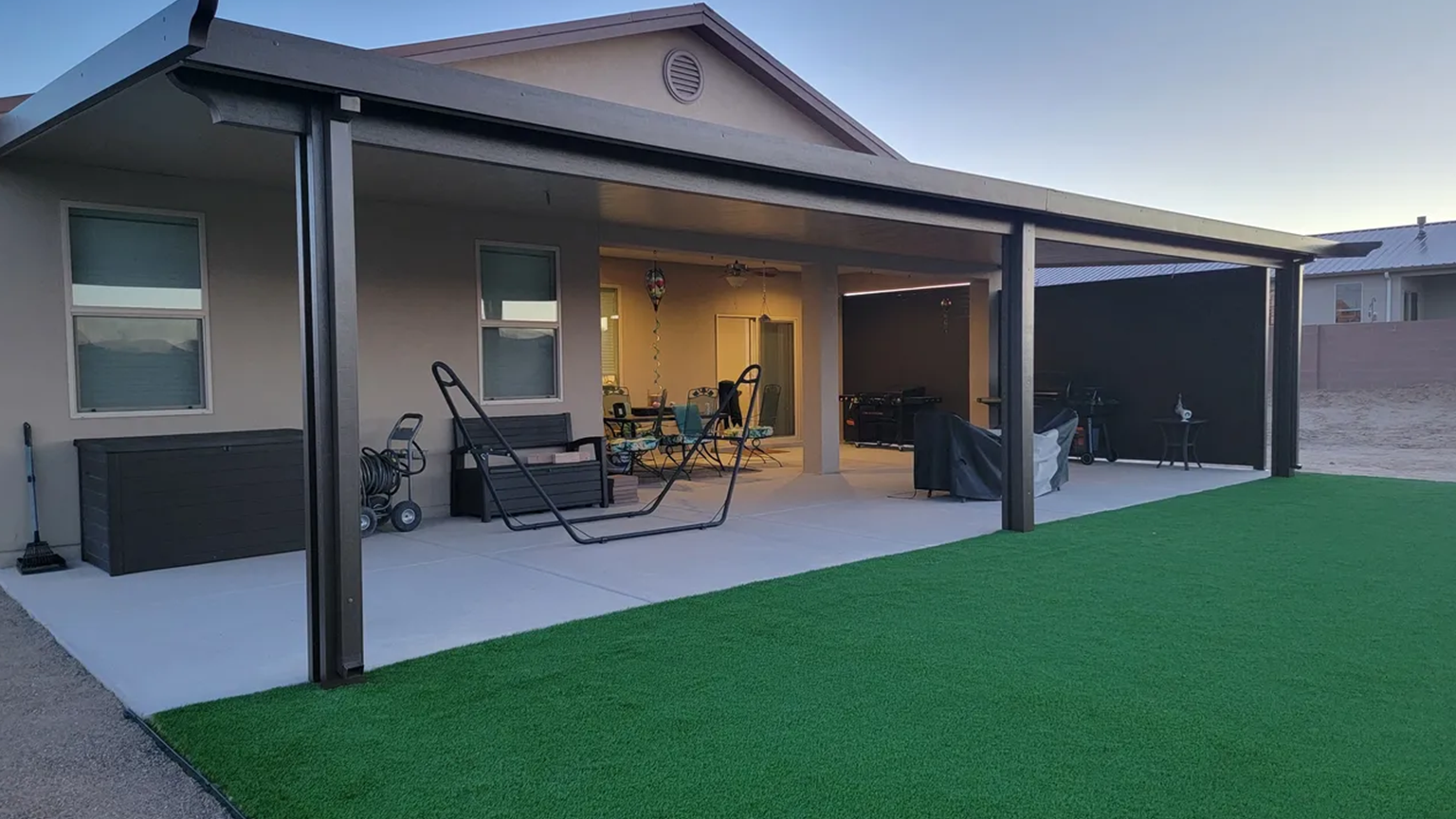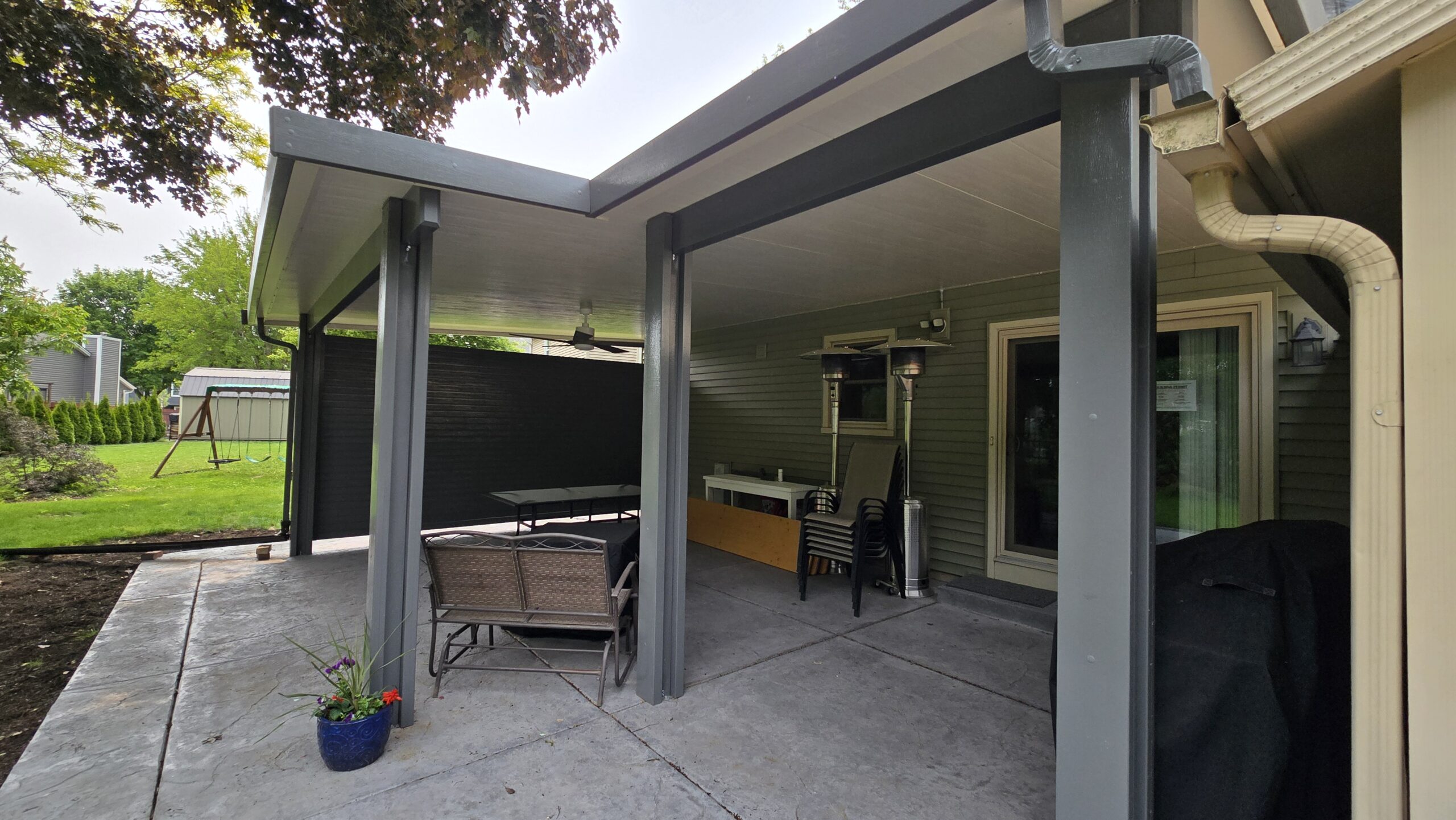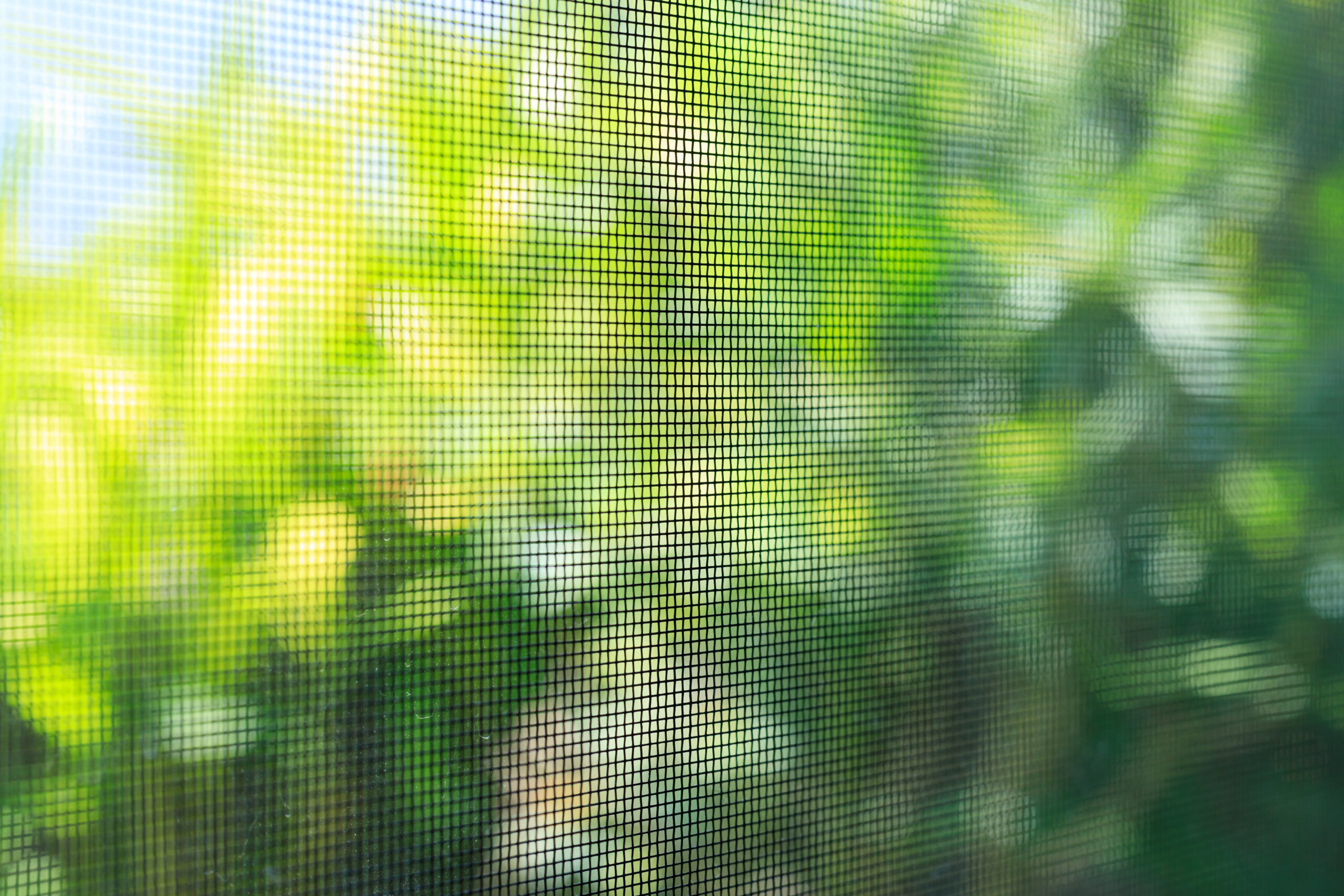
Why Screen in a Covered Patio for Bug Season
Warm weather brings cookouts, backyard movies, and sunset chats. It also brings mosquitoes, gnats, flies, and wasps. If you want the breeze without the bites, the most reliable fix is to screen in a covered patio. Adding screens or outdoor shades creates a comfortable zone where family and friends can relax, eat, and play without swatting at pests. This guide compares screens and shades, outlines costs, explains DIY versus pro options, and shows how Patio Cover Designs by S can help you get it done right.
Screens vs. Shades: What Is the Difference?
What patio screens do
Patio screens are mesh panels installed around the perimeter of your covered space. Their primary job is to block insects while maintaining airflow and visibility. Mesh openings vary. No-see-um screens keep out tiny midges, while standard insect screens focus on mosquitoes and flies. You can choose fixed frames for a permanent enclosure or sliding and hinged screen doors for easy access. With the right mesh, you maintain a view of your yard and enjoy cool ventilation.
What outdoor shades do
Outdoor shades are fabric panels that roll down to control sun, heat, and privacy. They can be manual or motorized. Typical fabrics include solar screens with 1 to 10 percent openness that filter glare and reduce heat. Some shade fabrics also resist bugs, but shades alone are not a complete bug barrier unless paired with side tracks or seals. Shades give you flexible control over light and privacy, which is why many homeowners combine them with traditional insect screens.
When to combine screens and shades
If you live where afternoons are hot and evenings are buggy, a hybrid approach is best. Install insect screens for full-time protection. Add roll-down shades on the exterior or interior for glare and privacy control. This combo lets you fine-tune comfort hour by hour. With a quality covered patio, you can enjoy morning coffee with the shades up, drop the shades for afternoon UV control, then settle into a bug-free movie night after dusk.
Popular Ways to Screen in Covered Patios
Fixed frame aluminum screens
Fixed frame systems are sturdy and low maintenance. Aluminum frames hold mesh panels in place around your cover’s posts and beams. You can add one or more screen doors depending on your layout. Fixed frames are ideal when you want a long-lasting, bug-tight solution that blends with the style of your patio cover. With Patio Cover Designs by S, frames can match your aluminum cover for a clean, unified look that will not rust.
Retractable and zipper-track screens
Retractable screens roll up when not in use and drop down when bugs arrive. Zipper-track or side-channel systems seal the edges to reduce gaps. These are available in manual crank and motorized versions. They are great for homeowners who want an open patio in the morning and an enclosed room by evening. Motorized units can integrate with remotes, wall switches, or smart controls.
Magnetic or removable panels for seasonal use
Seasonal panels use magnets, snaps, or clips to attach screens to existing posts. They are a flexible option for renters or budget-conscious homeowners. While they do not seal as tightly as framed or zipper-track systems, they offer a fast, affordable way to screen in a covered patio during peak bug season.
Clear vinyl panels for shoulder seasons
In cooler months, clear vinyl storm panels block wind and keep rain out while maintaining the view. Many systems pair vinyl panels with screens so you can swap depending on the season. This setup is perfect if you are thinking about a future 3-season or 4-season room upgrade.
Mesh and Fabric Options
Fiberglass, polyester, and stainless mesh
Fiberglass mesh is common, budget-friendly, and easy to work with. It offers good visibility and airflow. Polyester mesh is stronger and resists stretching. It is a smart choice around pets or kids. For coastal or heavy-wear areas, stainless steel mesh provides excellent durability and impact resistance, though it costs more and can slightly reduce visibility compared to standard mesh.
No-see-um, pet-resistant, solar, and privacy screen
No-see-um mesh uses smaller openings to block the tiniest pests, which is helpful near water or marshes. Pet-resistant mesh is thicker and resists claws. Solar screen fabric reduces heat gain and glare, which can help cool your patio and protect furniture. Privacy screen fabrics have tighter weaves that limit visibility from the outside. Mixing mesh types on different walls can solve different challenges, such as privacy on the street side and open views to the backyard.
Color choices and visibility
Darker mesh generally improves visibility because your eyes focus through it. Charcoal and black are popular. Lighter mesh can be more visible to birds and pets, which may prevent collisions, but it can affect outward visibility. Choose a color that matches your frame and desired view.
Cost Guide: Budget to Premium
Prices vary by size, materials, and features. Use these rough guidelines to plan your budget. Final costs will depend on your location and the specifics of your patio structure.
- DIY basic screen kits: 3 to 7 dollars per square foot for fiberglass mesh and simple aluminum frames
- Pro-installed fixed screens: 15 to 35 dollars per square foot depending on mesh type, framing details, and door count
- Retractable manual shades: 500 to 1,800 dollars per opening
- Motorized zipper-track screens: 2,000 to 5,000 dollars per opening depending on width, fabric, and controls
- Clear vinyl storm panels: 12 to 35 dollars per square foot for custom-fit panels
Factors that affect price
- Patio size and height
- Type of patio cover and attachment needs
- Mesh or fabric level, such as no-see-um, pet mesh, or solar fabric
- Number of doors, door style, and hardware
- Motorization, side tracks, and smart controls
- Electrical work for outlets, lighting, or ceiling fans
- Permits or engineering if structural changes are needed
DIY or Hire a Pro?
When DIY makes sense
If your patio cover is square, your openings are small to medium, and you are comfortable measuring and cutting frame pieces, DIY kits can save money. Basic tools include a miter saw, drill, level, and spline roller. Work patiently and check each opening for square and plumb. Seal gaps at the floor and roof line to keep bugs out. For roll-down shades, follow manufacturer instructions on bracket placement and tensioning.
When to choose a pro
Hire a pro if your patio has complex angles, nonstandard openings, or you want motorized screens that tie into electrical. A contractor will make precise cuts, hide fasteners, and ensure door thresholds are smooth and secure. Patio Cover Designs by S can also match new screens or shades with your existing aluminum cover color, style, and beam layout for a custom fit.
Permits and code considerations
Simple screens usually do not require permits, but additions like new roofs, structural posts, electrical circuits, and conversions to a 3-season room can trigger permits and inspections. Patio Cover Designs by S uses materials engineered to meet or exceed most building codes and can advise you on local requirements in Wisconsin and New Mexico.
Steps to Plan Your Project
- Measure the space. Record width, height, and any slopes at each opening. Note obstructions like railings or downspouts.
- Choose your protection level. Decide if you need standard insect control or no-see-um protection. Consider privacy or solar shading on sunny sides.
- Select fixed or retractable. Choose permanent framed screens for full-time bug control, retractable screens for flexibility, or a hybrid system.
- Plan doors and traffic flow. Place doors where people naturally move. Consider double doors for grill access or furniture moving.
- Integrate electrical. If you want motorized screens, fans, or lighting, plan wiring and switches before installation.
- Match finishes. Coordinate frame, mesh color, and hardware with your patio cover and home trim.
- Seal gaps. Add sill plates or sweep seals at the floor and weatherstrips at posts. Bugs find even small openings.
- Schedule installation. Choose a quiet weather window. If hiring a pro, ask about lead times, which can extend during peak season.
Integrating With Existing Patio Covers
Solid or flat pan covers
Solid aluminum covers make it easy to screen in a covered patio because they offer sturdy beams and a clean roof line. Screens mount to posts and header beams, and you can tuck weatherstrips under the roof channel for a tight seal. For heat control, add roll-down solar shades on the west and south sides.
Insulated covers with electrical
Insulated panels add comfort by reducing heat transfer and noise. If your cover already includes integrated electrical, it is simple to add a ceiling fan for airflow and a switch for motorized screens. Patio Cover Designs by S can retro-fit screens and shades to many insulated systems and wire controls neatly.
Open lattice covers
Lattice covers are beautiful and airy, but they are not weather tight. To screen in a lattice patio, many homeowners add side screens for bug control and then use roll-down shades or a clear polycarbonate roof panel upgrade for rain protection. Patio Cover Designs by S designs lattice patterns that deliver 40 to 90 percent shade, which pairs well with exterior shades to fine-tune light levels.
Combination systems
Combination covers blend solid and lattice sections. Screen the solid portion for a cozy seating area and leave the lattice portion open near the garden. You can also use screens everywhere and add a retractable shade only where the sun is strongest. A custom design session with Patio Cover Designs by S can map a plan that fits your yard, views, and daily routine.
Comfort and Performance Tips
- Promote cross-ventilation by placing doors or vent panels on opposite sides.
- Use darker mesh for clearer views and lighter mesh where visibility to the screen is helpful for pets.
- Install a ceiling fan to keep air moving and make bugs less active.
- Add a threshold or sill angle at the floor to close gaps that attract ants and spiders.
- Use caulk or gasket at posts and along the roof beam to seal tiny openings.
- Consider sun orientation. Use solar fabric on the hottest side, standard insect mesh elsewhere.
- Choose pet-resistant mesh for doors to prevent claw damage.
- Plan drainage. Keep the screen edge raised off the slab if water pools, or add a small channel to direct runoff.
- For winter, add clear vinyl panels or store roll-down fabrics per manufacturer guidelines.
Maintenance and Care
- Clean mesh twice per season with a soft brush and mild soap. Rinse gently.
- Inspect spline and corners each spring. Re-seat or replace if you see gaps.
- Lubricate hinges and check door closers for smooth operation.
- Dust roll-down shades and vacuum with a soft brush to protect coatings.
- Retract motorized screens during high winds if your system is not wind-rated.
- Store detachable vinyl panels flat or rolled with protective sleeves to avoid creases.
From Screened Patio to 3- or 4-Season Room
If you love your screened porch and want more months of use, consider an upgrade path. Many homeowners start by screening in a covered patio. Later, they add clear vinyl for wind control and finally step up to glass windows for a true 3-season or 4-season room. Patio Cover Designs by S builds sunrooms with durable aluminum frames, insulated roofs, and optional integrated electrical for fans and lighting. You can phase your project to spread out costs and match your goals over time.
Frequently Asked Questions
How long does it take to screen in a covered patio?
Basic DIY kits for small patios can be done in a weekend. Pro installations range from one to three days for fixed frames and two to five days for retractable systems, depending on size and electrical work.
Will screens make my patio too dark?
Standard insect mesh has minimal impact on light. Solar fabrics reduce glare and heat, which can be helpful on west and south exposures. You can mix mesh types to balance brightness and comfort.
Can I keep rain out if I only add screens?
Screens block bugs, not rain. To stop wind-driven rain, consider vinyl storm panels or a shade fabric with side tracks. If your roof is lattice, upgrade part of it to a solid cover for better weather control.
What is the best mesh for no-see-ums?
No-see-um mesh uses smaller openings to block tiny midges. It reduces airflow slightly compared to standard mesh but offers the best bug protection near lakes and rivers.
Do I need a permit to screen in a covered patio?
Screen-only projects often do not need permits, but local rules vary. Electrical, structural changes, or sunroom conversions may require permits. Patio Cover Designs by S can help you navigate requirements in Wisconsin and New Mexico.
How do motorized screens handle wind?
Many systems are rated for specific wind speeds. Zipper-track screens perform better because the fabric is captured in side rails. Always retract screens during storms if your system is not wind-rated for the conditions.
Why Choose Patio Cover Designs by S
Patio Cover Designs by S is a family-owned outdoor living contractor with more than 20 years of hands-on experience. Founded in 2016 by Crystal and Jason, the company brings manufacturing and project-management expertise to every job. They specialize in custom aluminum patio covers, sunrooms, carports, and decking. Their covers include Solid or Flat Pan, Insulated with optional integrated electrical, Open Lattice with 40 to 90 percent shade, and smart Combination systems. The team also builds privacy panels, awnings, cantilever covers, BBQ and pool equipment covers, and one-off solutions to fit unique homes.
Materials are premium aluminum that will not crack, warp, split, or need painting. Installations are engineered to meet or exceed most building codes and are backed by a transferable Full Lifetime Warranty. If you want to screen in a covered patio that looks like it was built that way from day one, Patio Cover Designs by S can color-match frames, hide fasteners, and integrate doors, shades, and electrical with a clean finish. They serve Wisconsin and New Mexico with personable, family-style service and straightforward estimates during weekday hours. Free design consultations make it easy to plan your project with confidence.
Get Started
Bug season does not have to chase you indoors. When you screen in a covered patio with the right combination of insect mesh and outdoor shades, you enjoy breezy comfort, clear views, and fewer pests. Decide on your priority, whether it is maximum bug control, glare reduction, privacy, or all of the above. Then choose between fixed frames, retractable screens, or a hybrid system. If you want expert guidance and a polished, long-lasting result, schedule a free consultation with Patio Cover Designs by S. Their team will help you compare options, estimate costs, and design a solution that fits your home and lifestyle. Your perfect patio season is a few smart choices away.

